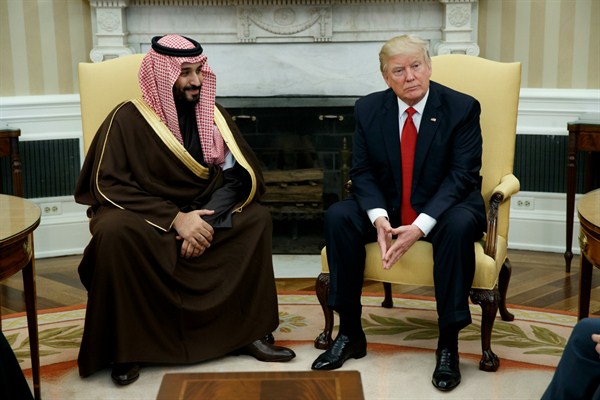This week, Mohammed bin Salman, Saudi Arabia’s powerful crown prince and the presumed real leader of the kingdom, arrives in the United States for a lengthy visit. On his trip, the 32-year-old prince, the architect of a newly bullish Saudi foreign policy, will likely address a wide range of bilateral and regional issues that have, on balance, strengthened U.S.-Saudi ties since Donald Trump became president. The visit is unlikely to herald any breakthrough in the nearly 10-month-long rift within the Gulf Cooperation Council, which pits Saudi Arabia, the United Arab Emirates and Bahrain—plus Egypt—against Qatar. Trump’s pro-Saudi instincts have made the more balanced mediation efforts of Defense Secretary James Mattis and outgoing Secretary of State Rex Tillerson less productive. The region, meanwhile, has settled into a long-term adjustment to the new status quo.
Mohammed bin Salman’s trip begins with much fanfare in Washington, where he will meet with U.S. officials. But then it turns into a country-wide tour, with stops in New York, Boston, Houston, Los Angeles, San Francisco and Seattle, for talks with influential economic, technology, energy and finance figures. The upstart prince is promoting his ambitious Vision 2030 initiative, a reform agenda for a more modern kingdom, which includes improving the status of women and diversifying the economy. Despite some setbacks, the plan has faced no serious resistance at home in no small measure because MBS, as he’s called, has actively cowed elites with high-profile detentions of some of the wealthiest Saudis and expanded social space for young people in the deeply conservative kingdom.
For Washington, managing relations with Saudi Arabia has never been easy. There’s a deep security partnership and important economic and business entanglements, but the enduring gaps in basic political values and regional priorities have always cast a shadow. In the past quarter century, the Saudis have alternately sought more American attention and support, only to then show disdain and disapproval of the results of U.S. action. They signaled during the George W. Bush and Obama administrations that they had come to see the U.S. as a less reliable partner—first because the American intervention in Iraq in 2003 tilted the regional balance toward Iran, and then because of the desire to scale back U.S. involvement in Iraq and a failure to make a difference in Syria’s civil war.

